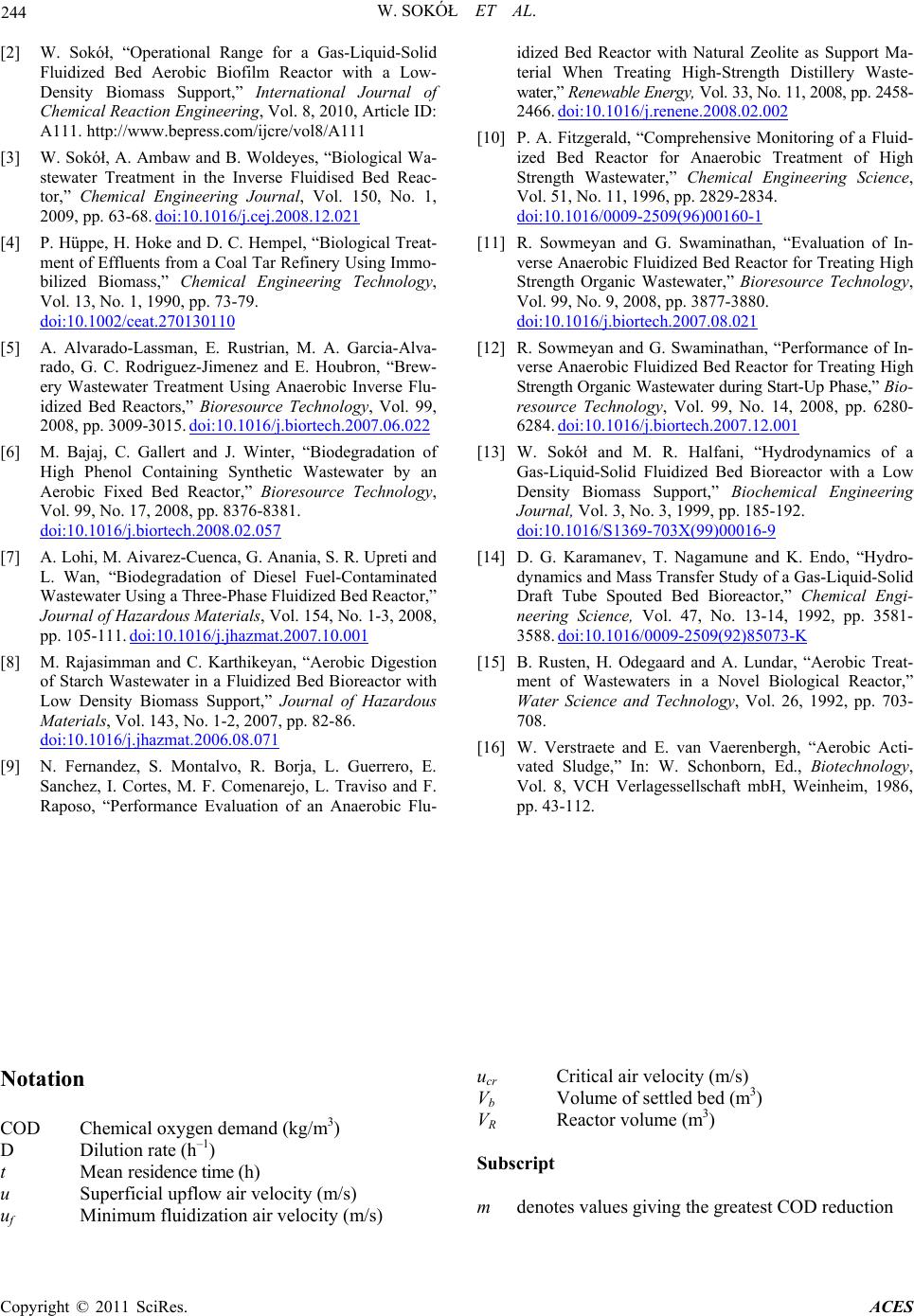
W. SOKÓŁ ET AL.
Copyright © 2011 SciRes. ACES
244
[2] W. Sokół, “Operational Range for a Gas-Liquid-Solid
Fluidized Bed Aerobic Biofilm Reactor with a Low-
Density Biomass Support,” International Journal of
Chemical Reaction Engineering, Vol. 8, 2010, Article ID:
A111. http://www.bepress.com/ijcre/vol8/A111
[3] W. Sokół, A. Ambaw and B. Woldeyes, “Biological Wa-
stewater Treatment in the Inverse Fluidised Bed Reac-
tor,” Chemical Engineering Journal, Vol. 150, No. 1,
2009, pp. 63-68. doi:10.1016/j.cej.2008.12.021
[4] P. Hüppe, H. Hoke and D. C. Hempel, “Biological Treat-
ment of Effluents from a Coal Tar Refinery Using Immo-
bilized Biomass,” Chemical Engineering Technology,
Vol. 13, No. 1, 1990, pp. 73-79.
doi:10.1002/ceat.270130110
[5] A. Alvarado-Lassman, E. Rustrian, M. A. Garcia- Alva-
rado, G. C. Rodriguez-Jimenez and E. Houbron, “Brew-
ery Wastewater Treatment Using Anaerobic Inverse Flu-
idized Bed Reactors,” Bioresource Technology, Vol. 99,
2008, pp. 3009-3015. doi:10.1016/j.biortech.2007.06.022
[6] M. Bajaj, C. Gallert and J. Winter, “Biodegradation of
High Phenol Containing Synthetic Wastewater by an
Aerobic Fixed Bed Reactor,” Bioresource Technology,
Vol. 99, No. 17, 2008, pp. 8376-8381.
doi:10.1016/j.biortech.2008.02.057
[7] A. Lohi, M. Aivarez-Cuenca, G. Anania, S. R. Upreti and
L. Wan, “Biodegradation of Diesel Fuel-Contaminated
Wastewater Using a Three-Phase Fluidized Bed Reactor,”
Journal of Hazardous Materials, Vol. 154, No. 1-3, 2008,
pp. 105-111. doi:10.1016/j.jhazmat.2007.10.001
[8] M. Rajasimman and C. Karthikeyan, “Aerobic Digestion
of Starch Wastewater in a Fluidized Bed Bioreactor with
Low Density Biomass Support,” Journal of Hazardous
Materials, Vol. 143, No. 1-2, 2007, pp. 82-86.
doi:10.1016/j.jhazmat.2006.08.071
[9] N. Fernandez, S. Montalvo, R. Borja, L. Guerrero, E.
Sanchez, I. Cortes, M. F. Comenarejo, L. Traviso and F.
Raposo, “Performance Evaluation of an Anaerobic Flu-
idized Bed Reactor with Natural Zeolite as Support Ma-
terial When Treating High-Strength Distillery Waste-
water,” Renewable Energy, Vol. 33, No. 11, 2008, pp. 2458-
2466. doi:10.1016/j.renene.2008.02.002
[10] P. A. Fitzgerald, “Comprehensive Monitoring of a Fluid-
ized Bed Reactor for Anaerobic Treatment of High
Strength Wastewater,” Chemical Engineering Science,
Vol. 51, No. 11, 1996, pp. 2829-2834.
doi:10.1016/0009-2509(96)00160-1
[11] R. Sowmeyan and G. Swaminathan, “Evaluation of In-
verse Anaerobic Fluidized Bed Reactor for Treating High
Strength Organic Wastewater,” Bioresource Technology,
Vol. 99, No. 9, 2008, pp. 3877-3880.
doi:10.1016/j.biortech.2007.08.021
[12] R. Sowmeyan and G. Swaminathan, “Performance of In-
verse Anaerobic Fluidized Bed Reactor for Treating High
Strength Organic Wastewater during Start-Up Phase,” Bio-
resource Technology, Vol. 99, No. 14, 2008, pp. 6280-
6284. doi:10.1016/j.biortech.2007.12.001
[13] W. Sokół and M. R. Halfani, “Hydrodynamics of a
Gas-Liquid-Solid Fluidized Bed Bioreactor with a Low
Density Biomass Support,” Biochemical Engineering
Journal, Vol. 3, No. 3, 1999, pp. 185-192.
doi:10.1016/S1369-703X(99)00016-9
[14] D. G. Karamanev, T. Nagamune and K. Endo, “Hydro-
dynamics and Mass Transfer Study of a Gas-Liquid-Solid
Draft Tube Spouted Bed Bioreactor,” Chemical Engi-
neering Science, Vol. 47, No. 13-14, 1992, pp. 3581-
3588. doi:10.1016/0009-2509(92)85073-K
[15] B. Rusten, H. Odegaard and A. Lundar, “Aerobic Treat-
ment of Wastewaters in a Novel Biological Reactor,”
Water Science and Technology, Vol. 26, 1992, pp. 703-
708.
[16] W. Verstraete and E. van Vaerenbergh, “Aerobic Acti-
vated Sludge,” In: W. Schonborn, Ed., Biotechnology,
Vol. 8, VCH Verlagessellschaft mbH, Weinheim, 1986,
pp. 43-112.
Notation
COD Chemical oxygen demand (kg/m3)
D Dilution rate (h–1)
t Mean residence time (h)
u Superficial upflow air velocity (m/s)
uf Minimum fluidization air velocity (m/s)
ucr Critical air velocity (m/s)
Vb Volume of settled bed (m3)
VR Reactor volume (m3)
Subscript
m denotes values giving the greatest COD reduction